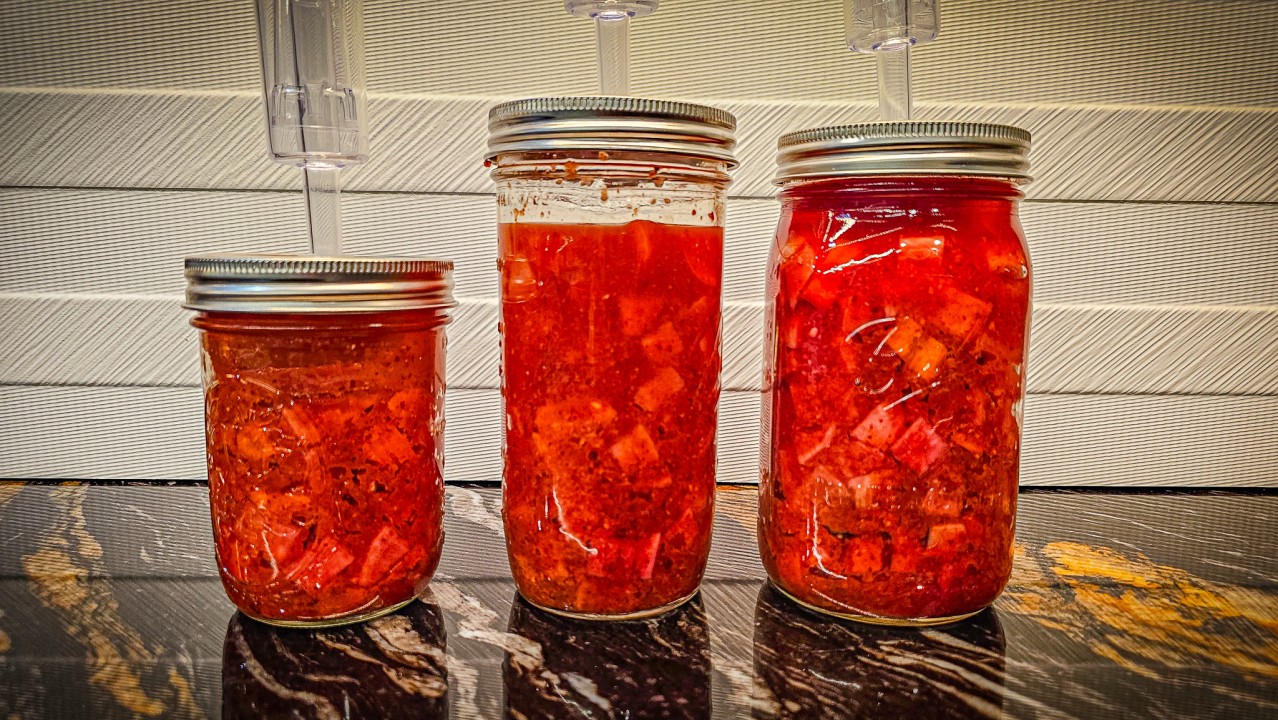You know that magical feeling when you transform ordinary ingredients into something extraordinary? That's exactly what happened when I started experimenting with this purple radish kimchi recipe. It all began with my fascination with fermentation – this incredible process that humans have been using for thousands of years to create everything from bread to wine to, yes, kimchi!
Let me tell you about this vibrant take on traditional kkakdugi (Korean radish kimchi) that's become a staple in my kitchen. Picture this: gorgeous purple radishes, crisp carrots, and sweet, juicy pears all mingling together with zingy garlic and ginger. Every time I open a jar, the aroma invigorates my soul. How is this even possible? Well, my friends, we are diving into that today.
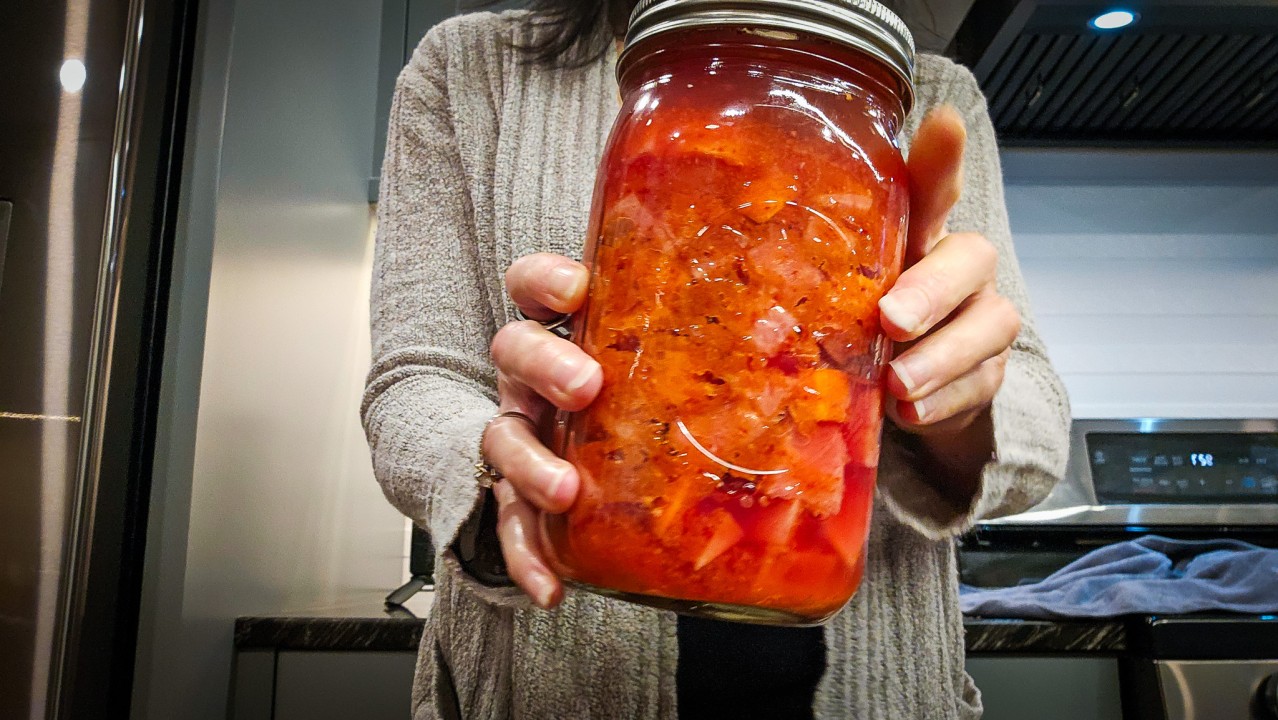
I had to show off this beauty!
I've spent countless hours tinkering with this recipe, and I've learned some fascinating things along the way. For instance, there's this beautiful dance between salt and sugar during fermentation – it's not just about taste, but about creating the perfect environment for those beneficial bacteria to thrive. Speaking of which, if you're new to fermentation, don't worry! I discovered that using a proper fermentation lid (I'll share my favorite one with you) makes the whole process practically foolproof. Trust me friends, if I can do it, so can you.
Are you ready to dive in and learn how to make this colorful, crunchy, totally addictive kimchi? Let's get fermenting!
The Magic Behind Every Jar: Our Star Ingredients
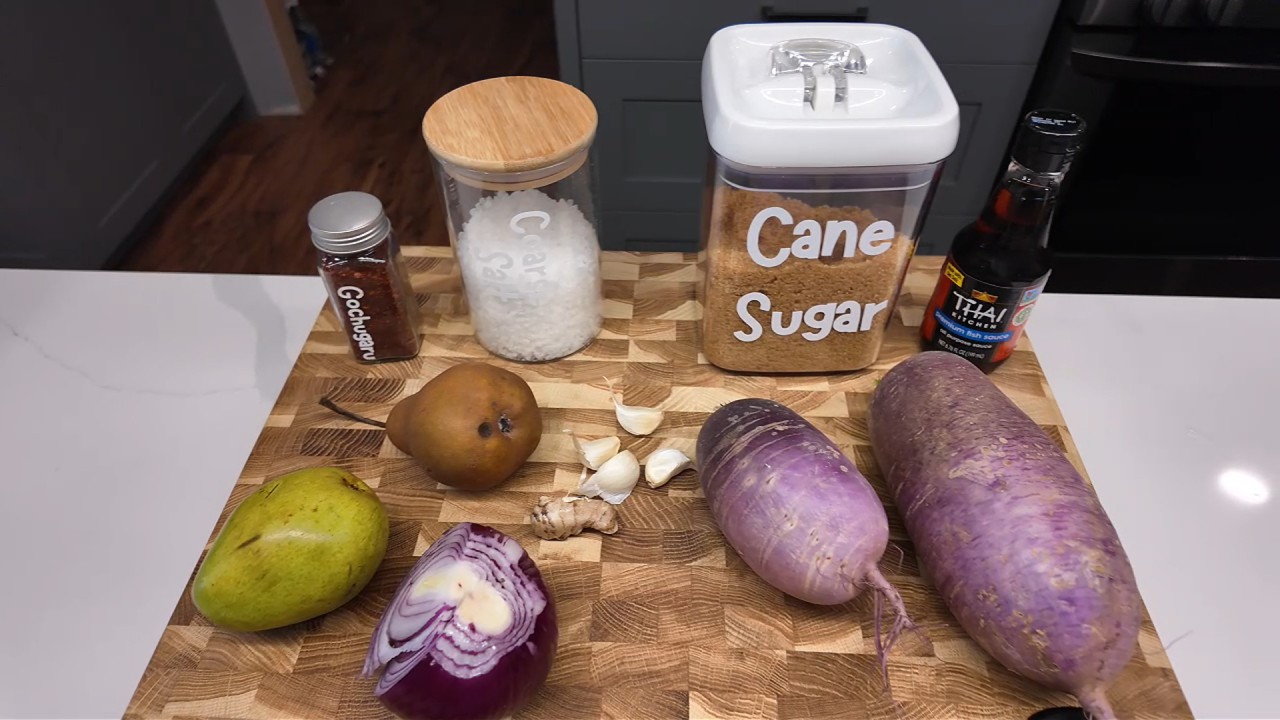
Simple, but effective for this gut nourishing creation. It doesn't take a lot friends!
There are many ways to make kimchi. When I was first considering creating a kimchi recipe, I wanted to use ingredients that were easy to find and also easy to work with. I don't know about you, but chopping vegetables into bite-size pieces seemed like a no-brainer to me. That's where the idea for a radish kimchi came to mind. I wanted something simple.
Radishes
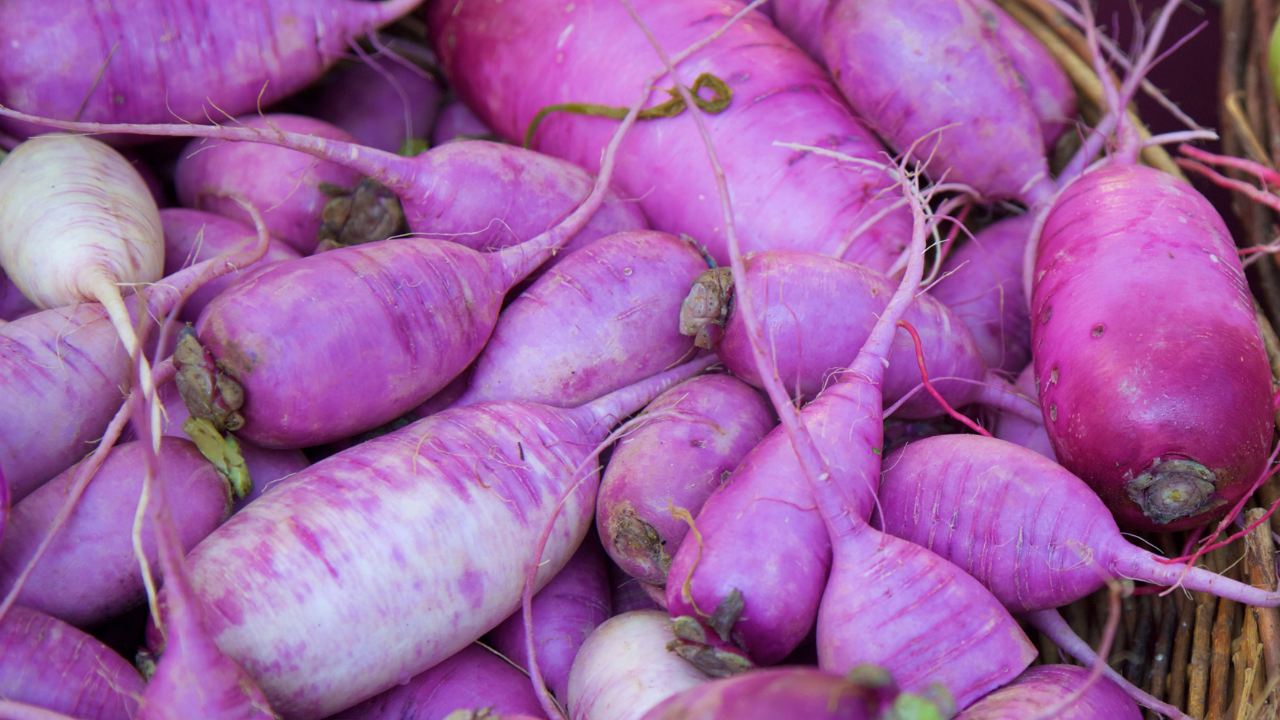
Purple radishes excite me like no other vegetable! Who's with me?
Without a doubt, the humble yet magnificent purple radish is the start of this show! You might be wondering why I chose this particular variety over the classic white Korean radish (mu) traditionally used in kkakdugi. Well, the story starts in my local farmers' market, where these vibrant beauties caught my eye and sparked my curiosity about creating something uniquely nutritious. Am I the only one who loves the color purple?
Think of purple radish as nature's two-for-one deal. Just like its white cousins, it brings that characteristic peppery bite and satisfying crunch we all love in kimchi. But here's where it gets really interesting – that stunning purple color isn't just for show. Those deep purple hues come from powerful compounds called anthocyanins, the same incredible antioxidants that make blueberries a superfood superstar. When I learned that these compounds could help fight inflammation and support heart health, I knew I had to incorporate them into my fermentation adventures.
What truly fascinates me about radishes is how they transform during the fermentation process. You see, these crunchy roots come equipped with their own natural enzymes that aid digestion. When we ferment them, it's like we're unlocking their full potential. The natural peppery kick that might be overwhelming in raw radish gradually mellows out, creating this incredible harmony with the other ingredients. It's similar to how a strong coffee becomes smoother and more complex when cold-brewed – time works its magic to develop deeper, more nuanced flavors.
One of my favorite aspects of using purple radish is its remarkable texture stability. Even after weeks of fermentation, each piece maintains that satisfying crunch that makes kimchi so addictive. I've discovered through much trial and error (and many taste tests!) that the key is cutting the radish into consistent, bite-sized cubes – about 1-inch pieces work perfectly. This size allows the radish to ferment evenly while retaining its structural integrity, ensuring that every bite delivers that perfect texture we're after.
Want to know a little secret? Sometimes I'll sneak a piece straight from the jar during the fermentation process to monitor how the flavors are developing. It's amazing to taste how the sharp, peppery notes gradually transform into something more complex and nuanced, while those beautiful anthocyanins work their magic behind the scenes. It's like watching a masterpiece slowly come to life, one delicious bite at a time.
Carrots
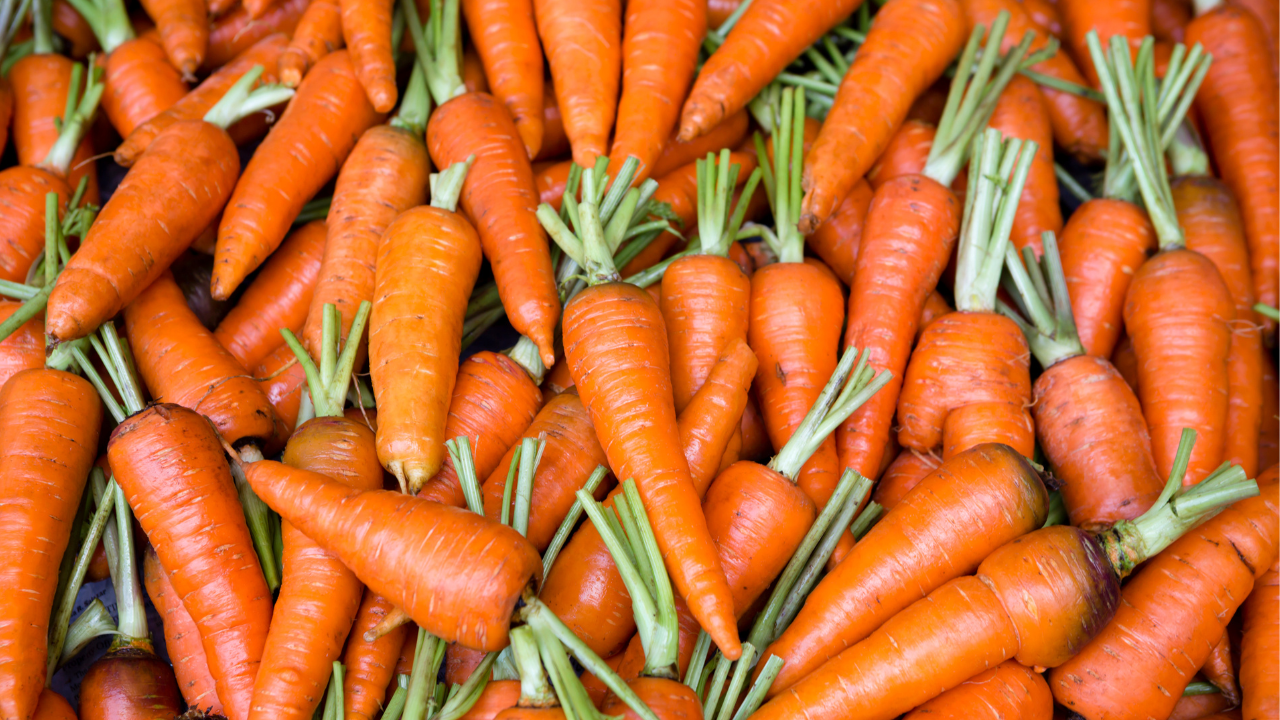
Orange carrots are another vegetable that just bring a smile to my face!
Let me tell you about our supporting star – the humble carrot! While our purple radishes might steal the spotlight, carrots play an equally crucial behind-the-scenes role in creating kimchi magic. You see, in traditional Korean cooking, the art of balancing flavors is paramount, and that's exactly where carrots shine. I also have been known to get a little "overly excited" when a local winery drops off a plate of these beauties for me to snack on! I devour every last bite!
Think of carrots as the quiet harmonizers in our fermented symphony. Their gentle sweetness does something remarkable – it softens the intense heat of the chilies and complements the salty, umami notes that develop during fermentation. If you've ever noticed how a splash of orange juice can brighten up a savory dish, carrots work in much the same way here, but with far more subtlety and complexity.
What's particularly fascinating is how carrots contribute to the fermentation process itself. During my recipe testing adventures, I discovered that their natural sugars serve as perfect nourishment for our beneficial bacteria. These microscopic helpers gradually transform these sugars, creating deeper, more complex flavors while producing those gut-healthy probiotics we're after.
The nutritional benefits of carrots in this recipe are just as impressive as their culinary contributions. Beta-carotene, their signature nutrient, doesn't just give them that beautiful orange color – it converts to vitamin A in our bodies, supporting everything from night vision to immune function. It's like getting a wellness boost wrapped in a delicious package!
And speaking of color – there's something almost poetic about how the bright orange of the carrots plays against the deep purple of our radishes. Every time I open a jar, this visual contrast reminds me of why I love fermentation so much: it's where science, nutrition, and artistry come together to create something truly special.
Have you ever noticed how some kimchi can be one-dimensionally spicy or salty? The carrots help prevent that by adding another layer of complexity to both the texture and taste. Their signature crunch persists through fermentation, creating this delightful textural interplay with our radishes that keeps each bite interesting and satisfying.
Pears
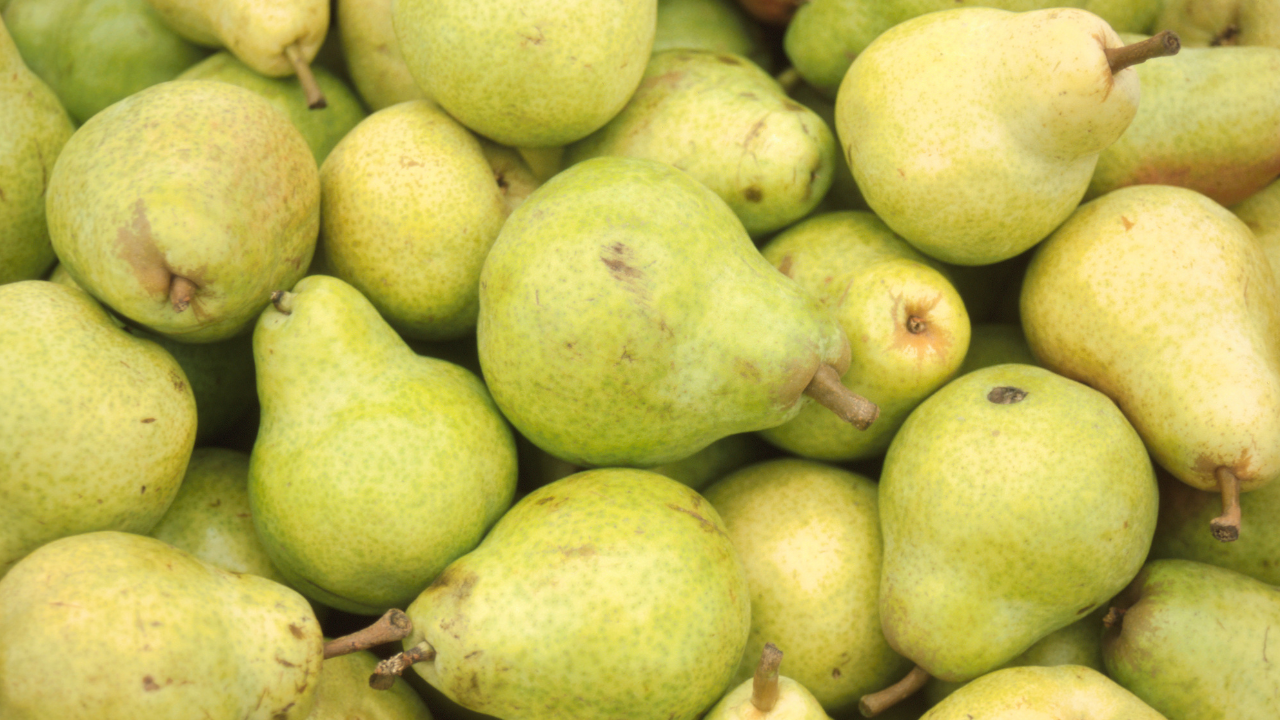
I've experimented with different varieties of our infamous pear. I love them all!
I discovered the magic of adding pears to kimchi during one particularly memorable fermentation experiment. While many modern recipes rely on sugar or other refined sweeteners, there's something special about letting pears work their natural magic. These juicy fruits bring a subtle sweetness that dances perfectly with the fiery gochugaru (Korean red pepper flakes), creating a beautiful balance that makes this kimchi uniquely crave-worthy. But what fascinates me most is how pears contribute far beyond just their sweetness – they're actually busy behind the scenes, working as nature's flavor engineers throughout the fermentation process.
You see, pears come equipped with their own special toolkit of enzymes and natural sugars that transform our kimchi in remarkable ways. These enzymes gently break down the tough fibers in our radishes, creating that perfect tender-yet-crunchy texture we're after. Meanwhile, their natural sugars feed our beneficial bacteria, helping create that probiotic-rich environment that makes fermented foods so incredible for gut health. It's like having a master chef and a wellness coach working together in every jar! The result is a kimchi that's not just deliciously complex but also packed with nutrients that processed sweeteners simply can't provide. Think of it as nature's own slow-cooking process, where time and pears work together to develop layers of flavor that keep evolving with each passing day.
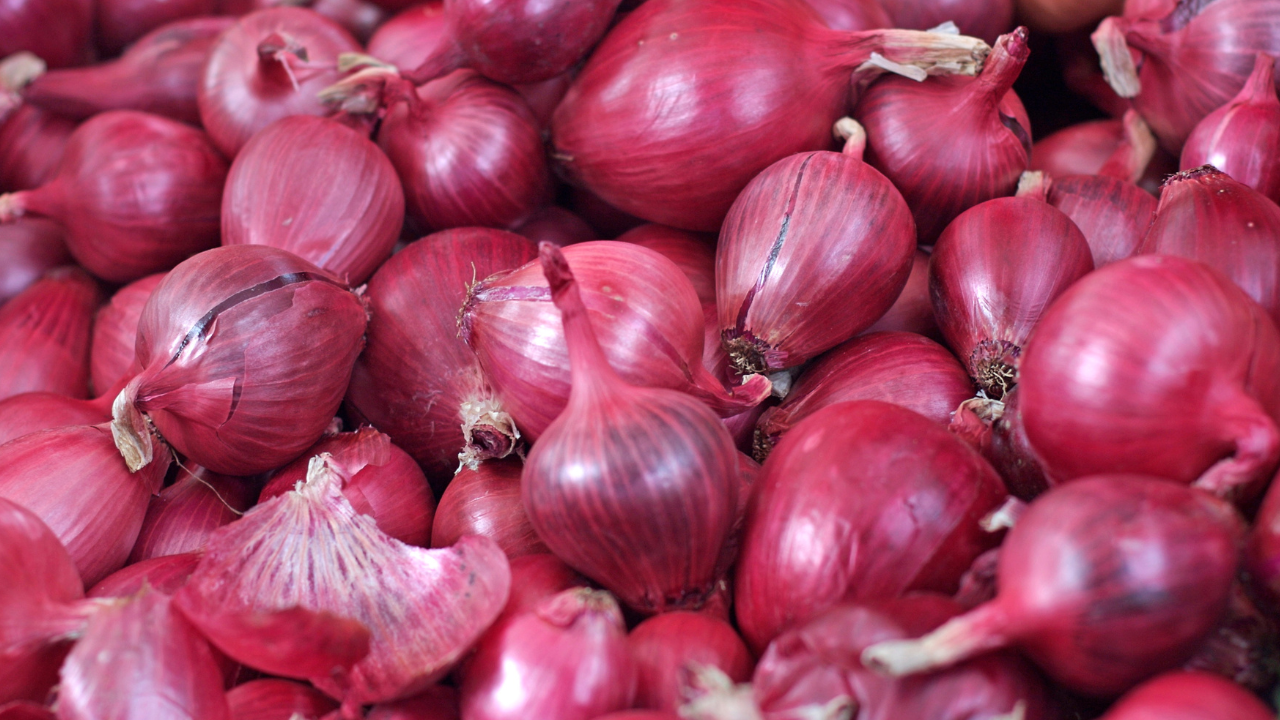
Red onions are probably one of my all-time favorite vegetables. They are so very good for our gut health!
Red Onion
We need to talk about another key player in our kimchi creation – the red onion. While it might seem unimportant, these vibrant purple rings bring something truly remarkable to our fermented masterpiece. They're packed with quercetin, a powerful antioxidant that's particularly abundant in red onions, making them both a flavor enhancer and a health supporter in our recipe. Think of quercetin as your body's personal bodyguard, helping to protect your cells while you enjoy your kimchi.
But here's where things get really interesting: red onions contain special fibers called prebiotics – essentially, they're serving up a feast for the beneficial bacteria that make fermented foods so special. It's like setting up a gourmet buffet for our microscopic friends! As these bacteria enjoy their prebiotic feast, they multiply and thrive, making our kimchi even more beneficial for gut health.
The transformation of red onions during fermentation is nothing short of magical. Over time, their initial sharp bite mellows into something softer and more complex, weaving seamlessly into the overall flavor tapestry of our kimchi. Each forkful delivers a perfect balance of textures and flavors, with our red onions playing their part in this delicious symphony while quietly supporting our digestive health.
Garlic
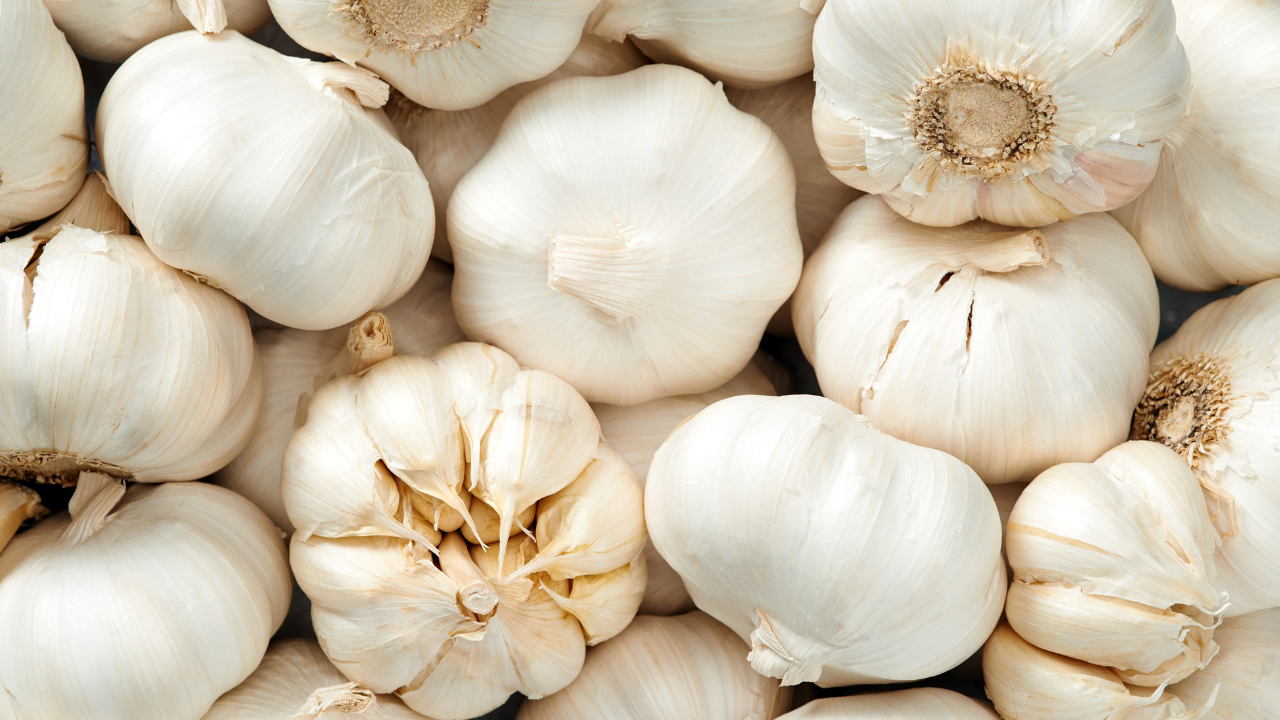
Fresh garlic is where it's at! I don't mess with the refrigerated jars of garlic. I always buy fresh whole garlic bulbs.
Ah, garlic – the ingredient that makes this kimchi truly come alive! You know that moment when you're mincing garlic and its intense aroma fills your kitchen? That's just the beginning of the magic it brings to our fermented creation. What fascinates me most about garlic is how it transforms during fermentation, like a boisterous party guest who gradually mellows into the most charming dinner companion.
Its initial sharp bite softens into this incredibly deep, complex savoriness that weaves all our other ingredients together. And while garlic has been prized in traditional medicine for centuries, modern science helps us understand why – it's packed with powerful compounds like allicin, which has antimicrobial and immune-boosting properties. This compound not only enhances the health benefits of kimchi but also helps create the perfect environment for beneficial bacteria to thrive during fermentation. It's like having a bouncer at the door of your kimchi jar, helping to keep the good guys in and the unwanted bacteria out!
When I first started experimenting with kimchi recipes, I learned that getting the garlic balance right is crucial – too little and you miss that characteristic depth, too much and it overwhelms the other delicate flavors we've worked so hard to develop. Through countless batches, I've found that when you get it just right, garlic becomes the thread that ties our entire flavor tapestry together, creating that unmistakable kimchi essence that keeps us coming back for more. Garlic is an absolute must in any kimchi recipe—it’s what gives it that unmistakable, punchy aroma. But beyond flavor, garlic is known for its antimicrobial and immune-boosting properties. It contains compounds like allicin, which help fight off bad bacteria while allowing beneficial probiotics to thrive. Fermenting garlic mellows its harsh bite, leaving behind a rich, savory depth that ties all the other ingredients together beautifully.
Ginger
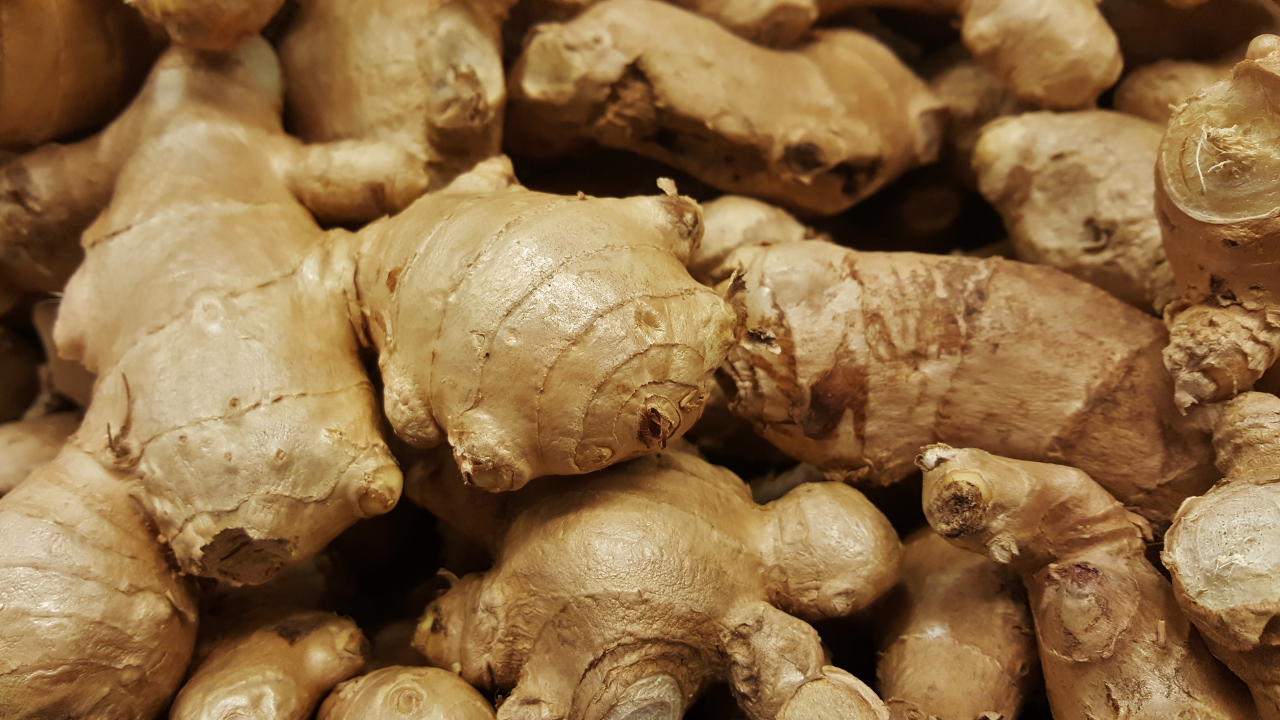
Ginger is something I have every single day! I love to add it to my morning smoothie.
Ginger is one of those ingredients that might seem subtle at first but plays a huge role in shaping the final flavor of kimchi. Slice into fresh ginger, and you’ll immediately notice its sharp, citrusy scent—a little burst of warmth that wakes up the senses. But what makes ginger truly special is how it evolves during fermentation. Initially, it brings a bright, slightly spicy kick, but as the kimchi ferments, it settles into a mellow, almost floral warmth that enhances every bite.
Beyond flavor, ginger is a powerhouse of health benefits. It's packed with gingerol, a potent anti-inflammatory compound that has been used for centuries to aid digestion, reduce nausea, and support immune function. When paired with the natural probiotics that develop during fermentation, ginger helps create a kimchi that not only tastes amazing but also actively nourishes your gut.
For me, ginger is like the secret ingredient that makes you go, “Wow, what is that?” without being able to put your finger on it. Too much, and it can overpower everything; too little, and the kimchi loses a bit of its magic. But get it just right, and it adds an incredible depth that makes each bite more satisfying. It’s the kind of ingredient that keeps you coming back for more, adding that final touch of warmth that ties all the flavors together. Ah, ginger – the fiery little root that brings warmth and complexity to this kimchi! Have you ever sliced into fresh ginger and been hit with that sharp, citrusy aroma? It’s like a little wake-up call for your senses. But what’s really fascinating is how ginger transforms during fermentation. Initially bold and spicy, it softens into a subtle yet persistent background note that ties all the flavors together, adding just the right amount of zing without overpowering the dish.
Ginger isn’t just here for flavor—it’s also a powerhouse of health benefits. Packed with gingerol, a potent anti-inflammatory compound, ginger has been used for centuries to aid digestion, soothe nausea, and even support the immune system. When combined with the natural probiotics from fermentation, ginger helps create a kimchi that’s not just delicious but also incredibly nourishing for your gut.
One of the things I love about ginger in kimchi is how it enhances the entire eating experience. It gives each bite a little spark of heat that lingers, making every mouthful feel dynamic and exciting. But balance is key—too much and your kimchi might taste overpoweringly spicy, too little and you miss out on its magic. Over the years, I’ve found that the right amount of ginger acts as the unsung hero of kimchi, quietly elevating the entire dish while offering a host of health benefits. It’s the ingredient that keeps you coming back for just one more bite! Ginger brings a gentle warmth and a touch of spice that deepens the complexity of kimchi. It’s also a well-known anti-inflammatory ingredient, packed with compounds like gingerol, which can aid digestion and soothe the gut. Many traditional fermented foods include ginger for both its flavor and health benefits, making it a staple ingredient in any well-rounded kimchi recipe.
The Flavor Powerhouses
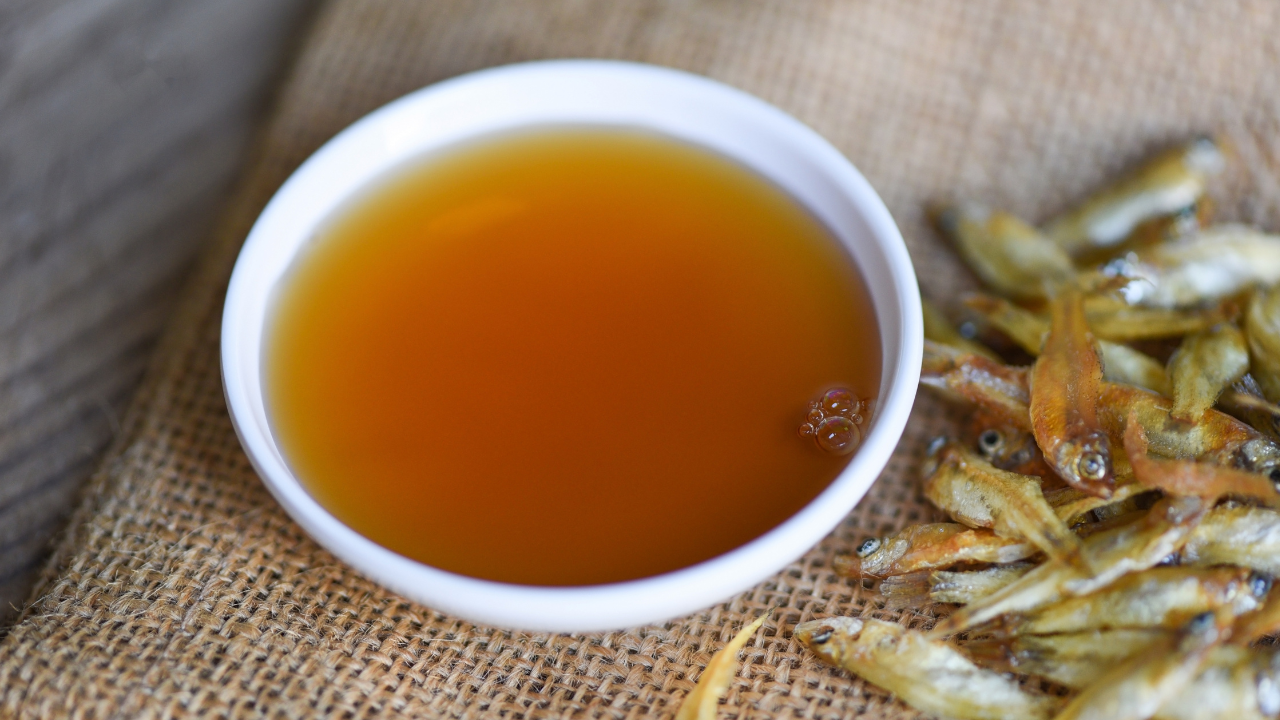
Fish sauce is a key ingredient as it provides a depth of flavor that is unparalleled.
Some ingredients in kimchi work like magic together, and fish sauce and gochugaru are two that play a major role in defining its deep, bold flavor.
Fish sauce brings that rich, savory umami depth that gives kimchi its unmistakable complexity. Made from fermented anchovies, it enhances every bite with a natural saltiness that amplifies all the other flavors. It also provides essential amino acids and minerals, making it more than just a seasoning—it's a nutritional booster that supports overall health.
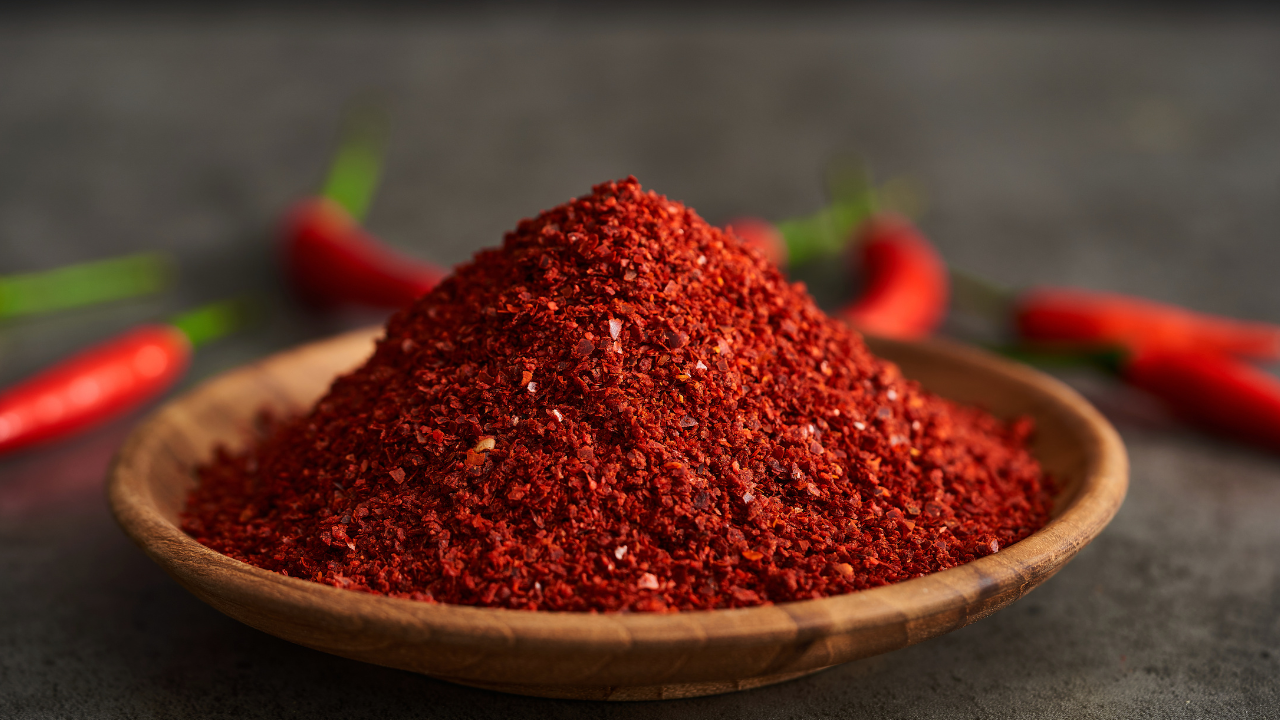
When I discovered gochugaru there was no going back!
Then, there’s gochugaru, the essential Korean red pepper powder. Unlike traditional chili flakes, gochugaru has a smoky-sweet heat that layers beautifully with the umami of fish sauce. The capsaicin in gochugaru not only gives it spice but also has anti-inflammatory properties, supports metabolism, and keeps your kimchi vibrant with its deep red color.
Together, these two ingredients create the foundation of the kimchi experience—one bringing the heat, the other grounding it with umami depth. Adjusting their balance lets you fine-tune your kimchi’s intensity, from a mild, nuanced heat to a bold, fiery kick.
Is Salt and Sugar Really Necessary?

Have you wondered about this too?
When it comes to fermentation, salt and sugar are more than just flavor enhancers—they’re functional ingredients that help regulate the entire process.
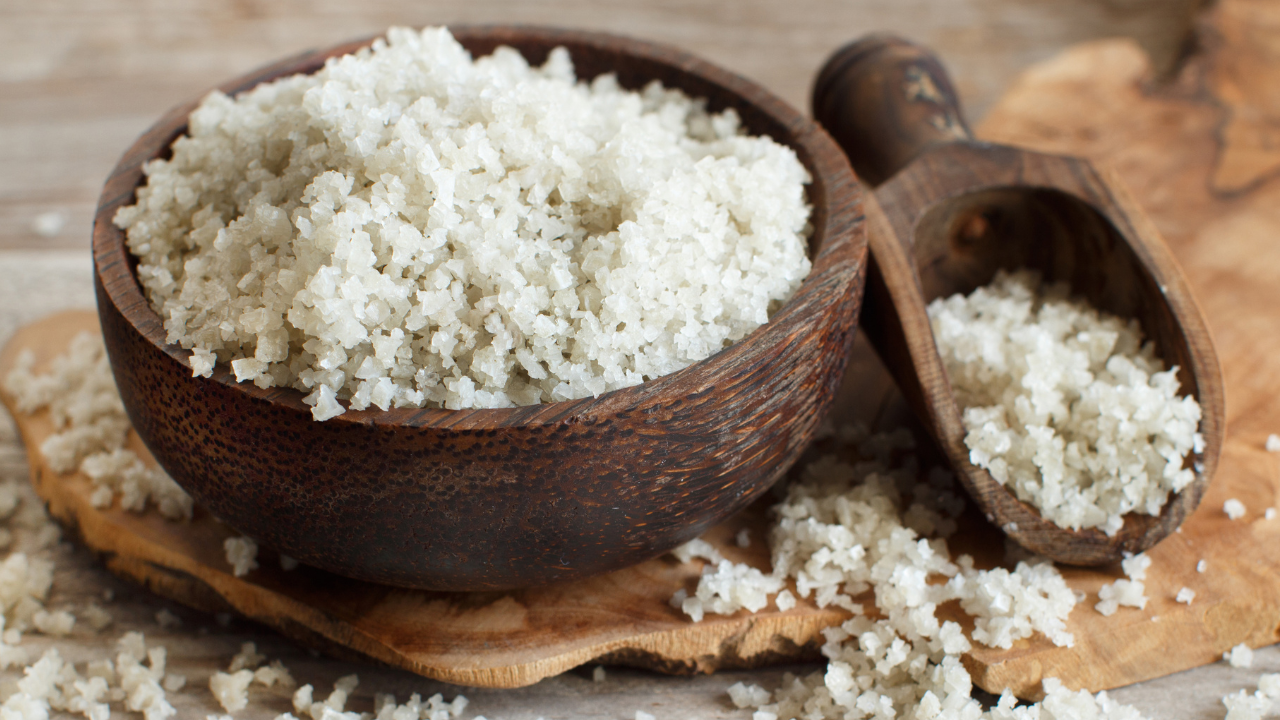
Celtic sea salt is packed with minerals that simple table salt does not have.
Salt is critical in creating the right environment for fermentation. Coarse Celtic sea salt draws out moisture from the radish, forming a natural brine that submerges the vegetables and prevents harmful bacteria from taking over. I didn't have to add any water! I do especially like using coarse salt for this recipe. I have used Mediterranean sea salt and had great results also. The minerals in sea salt also nourish the beneficial lactobacilli, encouraging them to thrive while slowing down unwanted microbial activity. Without salt, your kimchi would be at risk of spoilage and wouldn’t develop its signature depth of flavor. Be sure to not use iodized salt when making kimchi as it can interfere with the fermentation process.
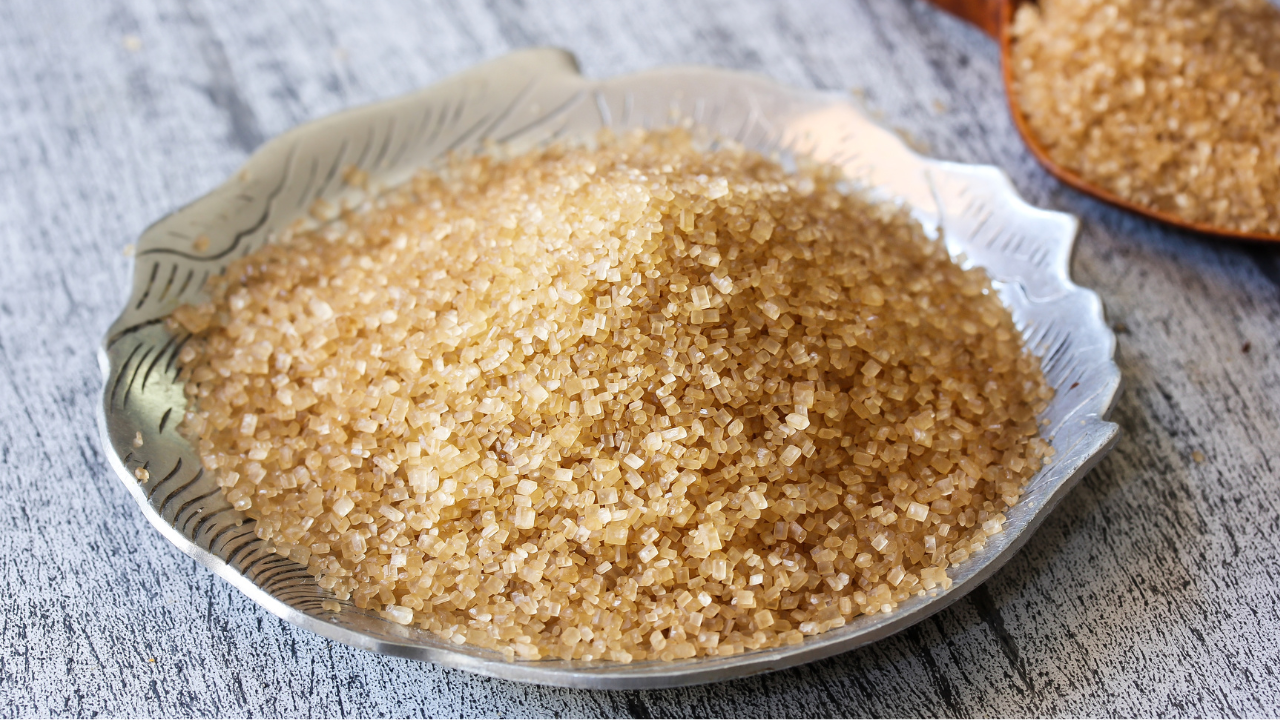
While I mostly steer clear of refined sugars, cane sugar is a must, in my opinion, in this recipe.
Sugar, on the other hand, acts as fuel for the fermentation process. Beneficial bacteria feed on the natural sugars present in cane sugar and pears, breaking them down to produce lactic acid, which preserves the kimchi and gives it that perfect tangy taste. Cane sugar also plays a role in balancing out the acidity and spice, creating a more rounded flavor profile. Although I normally do not add refined sugar to my recipes, I do find it essential to promote the growth of beneficial bacteria (who, by the way, are the ones actually eating the sugar in this dish).
Some might wonder if these ingredients are truly necessary, but experience shows that using high-quality salt and just the right amount of sugar ensures not just proper fermentation but a superior kimchi that is both delicious and probiotic-rich.
The Magic of Fermentation: Science Meets Flavor
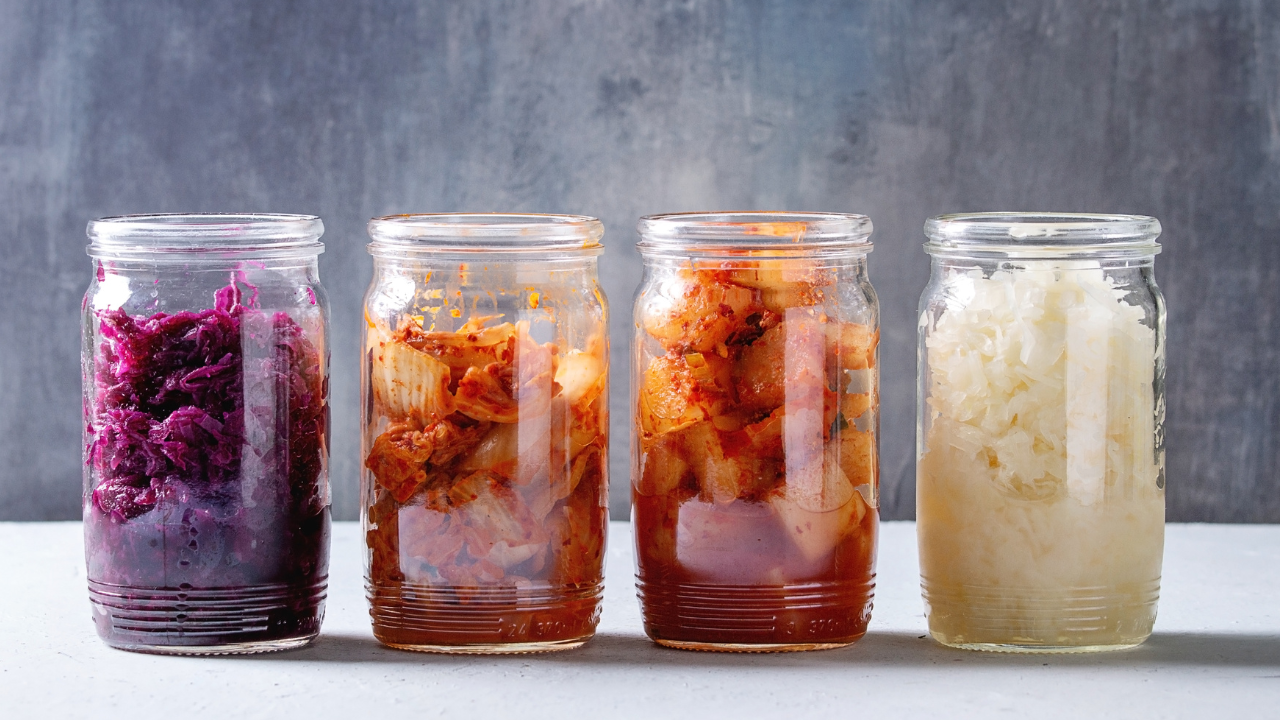
I love experimenting with fermenting different vegetables as it is a great way to ramp up your microbiome in the best way!
Fermentation is more than just an ancient preservation technique—it’s a fascinating, living transformation that brings depth, complexity, and gut-loving benefits to every bite. When you mix radish with salt, sugar, and the right balance of spices, you’re not just making kimchi—you’re creating an environment where beneficial microbes thrive, unlocking flavors that only time and nature can achieve.
At the heart of this process is lactobacillus, the friendly bacteria responsible for turning simple ingredients into probiotic powerhouses. These bacteria naturally exist on the surface of vegetables, waiting for the right conditions to work their magic. As soon as the radish is submerged in its brine, lactobacilli get to work, consuming the sugars from the pear and cane sugar and converting them into lactic acid. This is what gives kimchi its signature tangy taste while also making it naturally preserved, packed with gut-friendly probiotics, and resistant to harmful bacteria.
But there’s more to it than just microbes. Salt plays the role of the gatekeeper, ensuring that the bad bacteria stay out while the good ones flourish. Coarse Celtic sea salt draws moisture from the radish, forming the brine that keeps everything submerged and safe from spoilage. Without it, fermentation would be unpredictable, and the texture of the radish would be limp instead of crisp.
Then there’s sugar, the fuel that drives fermentation. While it adds a subtle sweetness, its real purpose is to feed the bacteria, allowing them to grow and produce the lactic acid that preserves the kimchi. Some might ask if sugar is really necessary, but without it, the fermentation process slows down, and the final flavor profile loses depth. The balance between salt and sugar is crucial—too much of either, and you risk overpowering the natural flavors or stalling the process.
Another key component is time. Fermentation doesn’t happen instantly—it’s a slow, gradual process where flavors develop and evolve. A freshly mixed batch of radish kimchi is bright, raw, and spicy, but give it a few days at room temperature, and it starts to mellow. The heat of gochugaru settles, the funkiness of the fish sauce deepens, and the sharpness of garlic and ginger softens into something rich and addictive.
And let’s not forget about oxygen—or the lack of it. Fermentation thrives in an anaerobic environment, meaning the less air exposure, the better. That’s where a fermentation lid comes in handy. It allows gases to escape while keeping oxygen out, reducing the risk of mold or unwanted bacteria. This simple tool ensures a foolproof ferment, even for beginners.
Fermentation is as much about patience as it is about science. The process might seem mysterious at first, but once you embrace it, you realize it’s a natural rhythm—an ancient dance of microbes and time, turning humble vegetables into something extraordinary. That’s the magic of kimchi, and every batch tells its own unique story of transformation, waiting to be discovered in every bite.
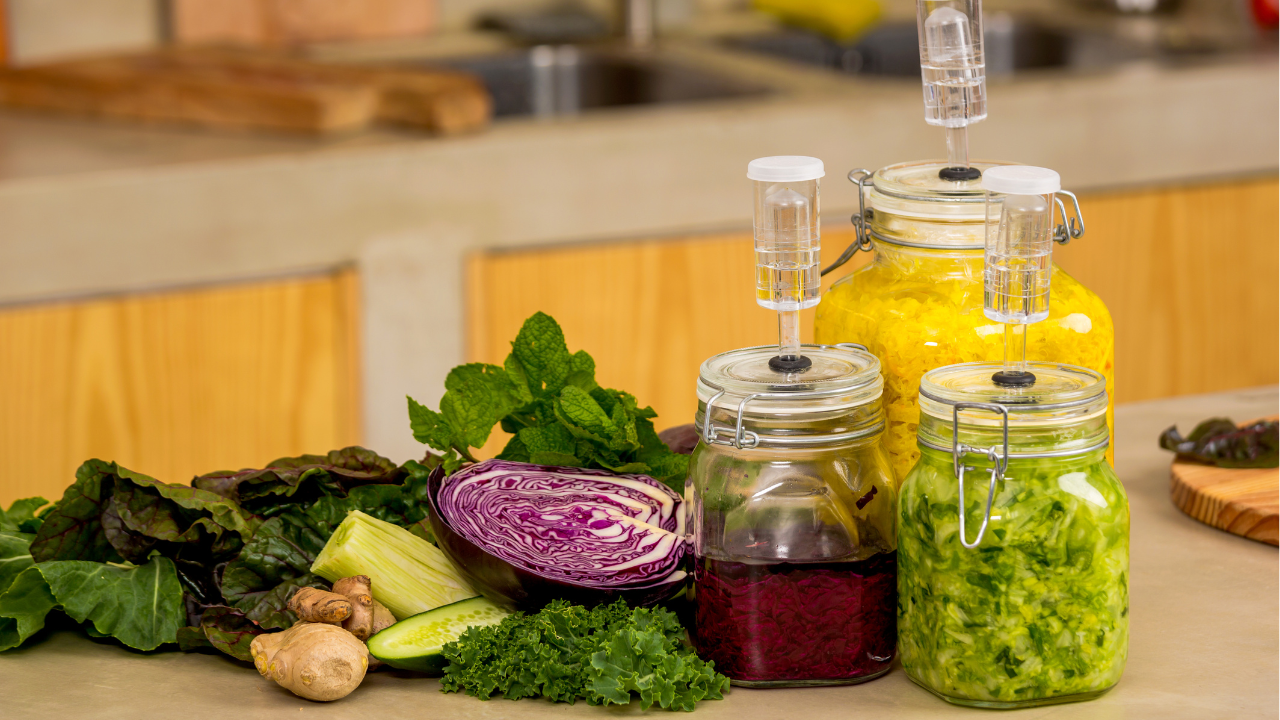
When I started using fermentation lids the whole process was just easier.
I tried to ferment vegetables many times without using a fermentation lid and I found it to be hit or miss. As soon as I picked one up I was wondered what took me so long!
Want to see which fermentation lids I use? I picked them up on Amazon here: Fermenting Lids
Are you convinced yet? To give fermentation a try? Once I made this recipe I didn't look back. Not only is it significantly cheaper to make it yourself, I also found that I no longer needed to take probiotics! My gut is so very happy :)
Want to watch how I did it and grab the recipe in the process? I'll see you on the other side...
